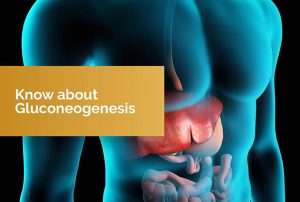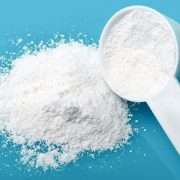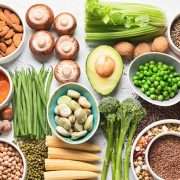What is Gluconeogenesis ?

Gluconeogenesis is pronounced as – gloo-ko-nee-oh-JEN-ih-sis. Okay, it’s not that difficult. Let’s start by breaking it into parts, Gluco – coming from glucose or sugar; Neo – meaning new and Genesis- being the origin of something, is a process that occurs in the liver and kidneys when the body has insufficient supply of carbohydrates. In other words, gluconeogenesis is the synthesis of glucose from noncarbohydrate sources like amino acids and glycerol. You can call it your body’s backup source that ensures you don’t die when there’s no carbs in your system.
Gluconeogenesis is an essential mechanism
When you workout or are physically active, you burn fuel and depending on the intensity of your exercise, you burn glucose and fat. Our brains need glucose to function optimally. Glucose is thereby the preferred source of fuel for the body.
After a medium to long workout, the system of our body uses liver’s stored glycogen, and fatty acids from stored fat. These provide us energy. It’s significant to note that our brains usually run on glucose only (a simple sugar or monosaccharide). So, when there isn’t enough glucose in the blood, our superior body functions are capable of producing it from non-carbohydrate sources as amino acids or glycerol 1.
Gluconeogenesis is also critical when you’re fasting. It helps to nourish tissues needing glucose, builds glycogen in muscles, and prevents hypoglycemia.
When Does Gluconeogenesis Happen?
Gluconeogenesis is something that is always happening. However, low carb consumption causes it to increase significantly.
There are 5 different metabolic states Gluconeogenesis usually manifests
1) Post Meal
Even though your body is relying majorly on the external carbs that you just consumed, internal glucose production (gluconeogenesis) continues to happen internally at a small rate.
Gluconeogenesis is not significant here, but it is there.
2) While Sleeping
Every night, during the 7-8 hours of sleep glucose is produced by the body. This happens because of two mechanisms: Glycogenolysis – the breakdown of glycogen and Gluconeogenesis.
Carb-based diet followers make more internal glucose via glycogenolysis than gluconeoheneisis.
3) During Intermittent Fasting
Rate of gluconeogenesis gets boosted a lot during Intermittent fasting .
Glucose is made up half by gluconeogenesis and half by glycogenolysis.
As per studies, 15-20 hour intermittent fast can produce up to 50-71% total glucose.
Therefore, during intermittent fasting, our bodies make glucose from gluconeogenesis and glycogenolysis almost equally.
4) During an Extended Fast
As your fasting continues, blood sugar level decreases gradually. However, the rate of gluconeogenesis kind of stays the same.
Your total glucose goes down because as glycogen stores run out glycogenolysis declines.
This means that when your body runs out of glycogen, it relies completely on gluconeogenesis.
5) Muscle Recovery

Recovery from prolonged strenuous exercise requires replenishment of depleted fuels so that tissues damaged can start getting repaired. Glycogen synthesis is a relatively slow process. The restoration of muscle glycogen requires extra attention and care when there is less time in between training sessions.
To maximise glycogen synthesis it is crucial to consume carbohydrates or proteins immediately post exercise. Adding protein improves the glycogen synthesis process by reducing the frequency of supplementation. This in turn promotes protein synthesis and reduces degradation of protein, thus adding the benefit of stimulating muscle tissue and repair.
Moreover, there is scientific research backed up with evidence that suggests consumption of protein supplements post-exercise has a more positive influence on exercise performance.
6) Eat sufficient proteins
Remember that sugar is not necessarily needed to make more sugar. Gluconeogenesis is there to replenish your glycogen stores. But all that is required to keep this process of churning going on in your body is protein.
When low-carb dieters don’t consume enough protein to preserve glycogen stores, their bodies use amino acids instead for energy. Ideally this is the state you would want your body to be in to burn more calories. So start fueling yourself with amino acids.
Here are some suggestions to help you find your ideal daily protein intake:
- If your lifestyle is more sedentary, we suggest between 0.6g and 0.8g protein per pound of lean body mass.
- If you have an active life, we suggest between 0.8g and 1.0g protein per pound of lean body mass.
- If you’re mostly into lifting weights, we suggest between 1.0g and 1.2g protein per pound of lean body mass.
Studies suggest that you should increase your protein intake if you have a lower body fat percentage or even when you are restricting calories. Whether you are lean or working out a calorie deficit to lose weight, it is important to stay at the higher end of the protein ranges that are suggested above. For example, sedentary individuals who are planning to restrict calories to lose weight should consume 0.8 grams of protein per pound per day instead of 0.6 grams of protein per pound per day.
Plix plant protein has 25g of protein in each serving that helps build lean muscles and improves endurance in the long run. It is 100% natural, is lactose free, and contains no sugar, soya or gluten in it.
Moreover, it’s available in easy to carry sachets that you can take with you at your gym. Try Plix for a healthy and fitter you.














